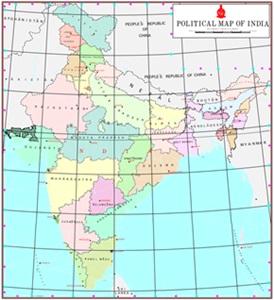The home ministry issued a notification on Saturday detailing the boundaries of the newly created union territories of Jammu and Kashmir and Ladakh. Along with the notification the government also released a new political map of India - one that now includes areas previously labelled as Pakistan-occupied Kashmir (PoK).

The order comes two days after the nation's newest union territories were formally created and received their first Lieutenant Governors; former union expenditure secretary Girish Chandra Murmu was sworn in as the first Lieutenant-Governor of Jammu and Kashmir and former Defence Secretary Radha Krishna Mathur was sworn in as the first Lieutenant Governor of Ladakh.
According to the notification, the union territory of Jammu and Kashmir will constitute all districts of the former state except Kargil and Leh, which will form the union territory of Ladakh.
In 1947, the former state of Jammu and Kashmir had the following 14 districts - Kathua, Jammu, Udhampur, Reasi, Anantnag, Baramulla, Poonch, Mirpur, Muzaffarabad, Leh and Ladakh, Gilgit, Gilgit Wazarat, Chilhas and Tribal Territory.
By 2019, the state government of former Jammu and Kashmir had reorganised the areas of these 14 districts into 28 districts. The names of the new districts are as follows - Kupwara, Bandipur, Ganderbal, Srinagar, Budgam, Pulwama, Shupian, Kulgam, Rajouri, Ramban, Doda, Kishtivar, Samba and Kargil.
Out of these, Kargil district was carved out from the area of Leh and Ladakh district. The Leh district of the new union territory of Ladakh has been defined in the Jammu and Kashmir Reorganisation (Removal of Difficulties) Second Order, 2019, issued by the President of India, to include the areas of the districts of Gilgit, Gilgit Wazarat, Chilhas and Tribal Territory of 1947, in addition to the remaining areas of Leh and Ladakh districts of 1947, after carving out the Kargil District.
The new maps have been prepared by Survey General of India to depict the new union territories of Jammu & Kashmir and Ladakh, as created on 31 October 2019, along with the map of India.
With the bifurcation of Jammu and Kashmir, the number of states in India has come down to 28 and the number of union territories has gone up to nine.
The centre paved the way for the bifurcation by ending special status on 5 August, fulfilling the BJP's long-standing promise to do so in the first 100 days of its second term in power. The government reasoned that both Article 370 and 35A were "constitutionally vulnerable" and discriminatory and inhibited the development of the state.
Hundreds of local politicians, including former chief ministers Farooq Abdullah, Omar Abdullah and Mehbooba Mufti have been under detention since the government announced the sweeping changes on 5 August. Under rhe new dispensation, they have also been asked to vacate their official residences.
The restrictions, especially the clampdown on communication, were necessary to prevent a possible backlash and terror strikes following the Article 370 decision and would be withdrawn in phases, the government had said.
The government has also said that Jammu and Kashmir will not stay a union territory and its statehood will be restored at an "appropriate time" once "normalcy" returns.








.webp)














